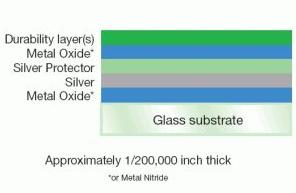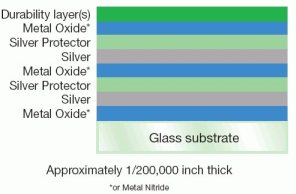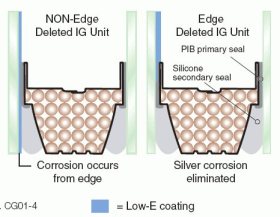

Background :
Low Emissivity (Low-E) coatings were developed to fill the need for insulating glass (IG) products to have better thermal performance. These coatings have been successfully used in residential and commercial applications since 1983. The silver metallic layer(s) in the low-E coating stack provide the beneficial summer daytime and winter night time performance.
When low-E coatings were developed for use in IG constructions, all experience and testing indicated that these coatings would need to be completely removed from the periphery of the glass (edge deletion) to eliminate silver corrosion at the glass edge.
Low-E coatings produced by a vacuum deposition process called Reactive Mangnetrom Sputtering (RMS) are made with multiple coating layers. Advanced generation of RMS low-E coatings have two silver layers, which has gained wide
acceptance.
|
|
|
| Figure1 | Figure2 |
Check out figure 1(single silver layer) and figure 2(double silver layer).
On both single and double silver coatings, durability layers are placed at the top of the coating stack. These layers protect the silver from shipping to fabrication of IG units. However, these layers are on the face of the coating and not on the coating edge. When the glass is cut into required sizes, the silver at the glass edge is directly exposed to the environment. If coating corrosion due to exposure to moisture or adverse chemicals is to occur, it will most likely begin at the edge, where the silver in the coating stack is exposed.

Figure 3 : showing Edge / Non - Edge Deleted IG unit
Procedures:
It is recommended that the low-E coating be completely deleted around the periphery of the glass, as shown in Figure
3. Since the low-E coating contains multiple coating layers, all layers should be removed to ensure adequate and consistent adhesion of the sealanats. The coating should be deleted using an edge grinding technique that removes all the coating down to the glass surface. The deletion should reach to a height that does not contact the sealant(s) or, in a dual-seal system, to a minimum of half the primary sealant height.
Advantages and Disadvantages :
The main disadvantage of edge deletion is its cost.
In the long run, the cost of replacing an IG unit far outweighs the cost of edge deletion.